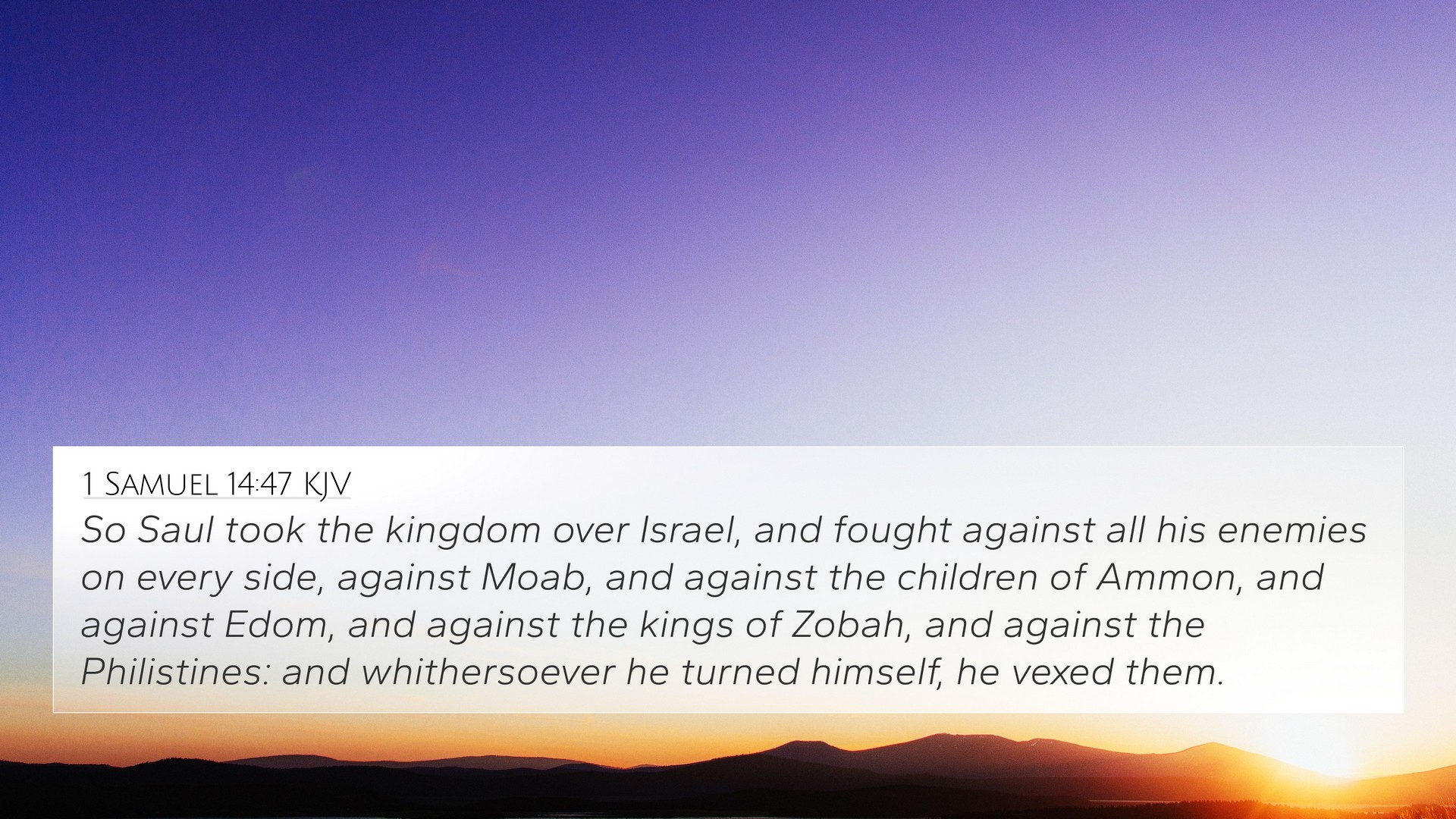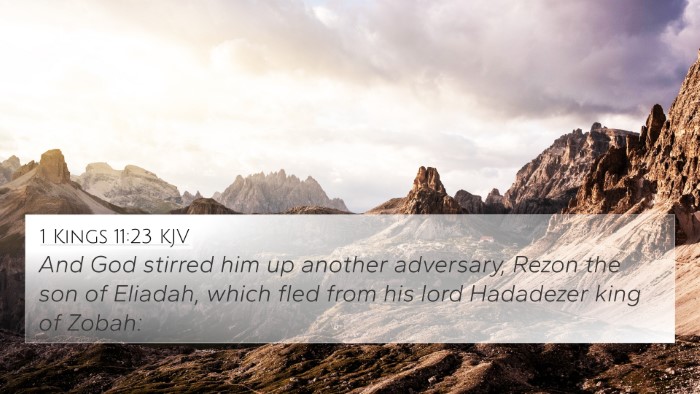Understanding 1 Samuel 14:47
In 1 Samuel 14:47, the verse states: "So Saul took the kingdom over Israel, and fought against all his enemies on every side, against Moab, and against the children of Ammon, and against Edom, and against the kings of Zobah, and against the Philistines: and whithersoever he turned himself, he vexed them."
This passage marks a significant moment in the reign of Saul, the first king of Israel, highlighting both his military campaigns and the challenges he faced. The verse encapsulates his efforts to establish and solidify his rule amid numerous adversaries.
Verse Context and Its Meaning
The immediate context of 1 Samuel 14:47 shows Saul's military endeavors, which were instrumental in shaping the political landscape of Israel during his reign. He faced hostile nations that threatened Israel's sovereignty and stability.
Insights from Public Domain Commentaries
-
Matthew Henry:
Henry emphasizes Saul's role as a general rather than solely a king, illustrating how he engaged in consistent warfare against the surrounding nations. The phrase "whithersoever he turned himself" indicates Saul's proactive approach rather than reactive. Saul's victories, while notable, would later be overshadowed by his failures in obedience to God.
-
Albert Barnes:
Barnes provides an analysis of the enemies mentioned: Moab, Ammon, Edom, and the Philistines, noting their historical conflicts with Israel. He suggests that Saul's military endeavors were partially defined by the need for Israel to defend itself against these longstanding foes. Barnes also alludes to the political implications of Saul's actions in navigating the complexities of regional power dynamics.
-
Adam Clarke:
Clarke discusses the significance of Saul's military struggles, portraying them as a backdrop for understanding the future transition to David's kingship. He notes that Saul's victories initially brought stability, but his inability to follow divine instruction later contributed to his downfall, setting the stage for David's rise.
Bible Verse Cross-References
This verse connects to several other passages in the Bible that discuss themes of kingship, military endeavors, and God's covenant with Israel. Key cross-references include:
- 1 Samuel 9:15-16: God's choice of Saul as king.
- 1 Samuel 15:1-3: God's command to Saul regarding the Amalekites.
- 1 Samuel 28:18: God’s rejection of Saul due to disobedience.
- 2 Samuel 5:17-25: David’s battles against the Philistines.
- 1 Chronicles 10:13-14: Summary of Saul's death and disobedience.
- Psalms 106:34-39: Israel's historical struggles with the nations.
- Deuteronomy 20:1-4: Instructions for warfare.
Thematic Bible Verse Connections
The themes found in 1 Samuel 14:47 can be paralleled with other scriptural contexts. These connections reveal insights into God's providence and the nature of leadership:
- Leadership Challenges: The struggles of Saul can be linked to the experiences of other biblical leaders, such as Moses (Exodus 17:8-16) and David (1 Samuel 17:40-50). Both faced overwhelming odds yet relied on God's support to achieve victory.
- Divine Authority: Cross-referencing Saul's military actions with God's commands (such as in Deuteronomy 20) highlights the biblical principle of seeking God's guidance in leadership and warfare.
- The Cycle of Sin and Redemption: Saul's narrative foreshadows Israel's cyclical pattern of faith and failure, as seen in the Book of Judges and throughout the prophetic books.
Scriptural Cross-Referencing Tools
For those seeking to delve deeper into the connections between Bible verses, various tools can assist in cross-referencing:
-
Bible Concordance:
This tool helps identify keywords and their occurrences throughout the Bible, aiding in finding related verses.
-
Bible Cross-Reference Guide:
A structured resource that organizes scripture links by themes or topics.
-
Cross-Reference Bible Study:
A method for studying scriptures that focuses on related passages to gain deeper understanding.
-
How to Use Bible Cross-References:
Guides can assist individuals in identifying and utilizing cross-references effectively.
Conclusion
1 Samuel 14:47 serves as a pivotal verse in understanding the complex nature of Saul's reign and the religious-political context of ancient Israel. By examining this verse through a lens of public domain commentaries and cross-referencing with other biblical texts, readers can attain a broader understanding of God's plan, the significance of fidelity in leadership, and the consequences of disobedience.
Engaging with the Bible using cross-referencing tools and themes enhances one's study, allowing for a richer interpretation and deeper connection with the scriptural narrative woven throughout both the Old and New Testaments.










